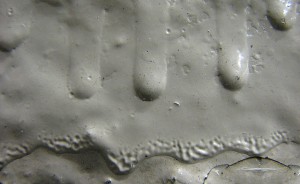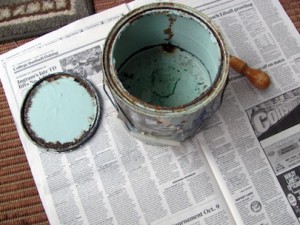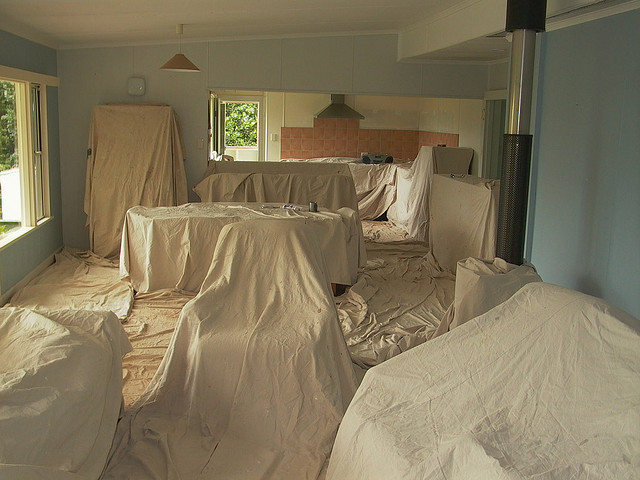Do you consider the careful monitoring of drips to avoid getting them on the floor, windows, and furniture the biggest hassle of an interior paint job? If so, there may be more to consider than you’ve realized. While painting your interior walls is a cost-effective way to give your home a beautiful facelift, there are many things which could potentially go wrong on a do-it-yourself paint job. The more you know, the better you can avoid problematic results on your painting project.
A professional interior home painter knows that protecting the home and limiting the disruption caused by the painting job are two high priorities for the homeowner. Your home and furniture will always be kept clear of any paint drips or other damages, but the best part of a professional painter is the swiftness of the job. The floor to ceiling sheets will not be a longtime fixture in your home like some do-it-yourself projects turn out to be.
Professional painters also know how to navigate the following additional painting sticky situations:
Blisters or Paint Bubbles

Let Radcliffe Painting, Inc. take care of all your painting needs before you try and do it yourself. Avoid Drips
The trickiest thing about paint bubbles is that they may not form until after the paint on the wall has already dried.
There are steps you should take to prevent bubbles from popping up.
When paint separates from the surface it’s applied to, that’s when blistering or bubbling occurs. There are a number of
possible reasons why paint film lifts, such as:
• The painting surface is damp, hot, or dirty
• Latex paint is exposed to moisture soon after the paint dries
• Alkyd or oil-based paint is applied over latex paint
• There is excessive moisture in the room
Sticking Paint
If you’ve ever had doors that stick in the doorway, you may know what a nuisance paint blocking or sticking can be. Paint blocking boils down to being an adhesion problem created when freshly painted surfaces are pressed together and stick. When the surfaces are separated, they show peeling or paint transfer.
Paint blocking can occur because low-quality gloss or semi-gloss paints are used or because not enough time is allowed for the paint to cure before windows or doors are closed.
In-Can Problems
There are quite a few reasons that you could have in-can problems with your paint which affects the outcome of your paint job. Examples of in-can problems include:
• If a sheet of skin is stirred or shaken into the paint, the skin is dispersed into many hundreds of tiny lumps. Skinning can occur for several reasons, including leaving the paint can open. WHAT IS PAINT SKIN? ANSWER: Skinning in paint Resene has done extensive research on the causes of skinning in paint and has identified that as the temperature starts to increase outside the pail, the air between the lid and the bulk paint will heat up quicker than the bulk paint. The paint on the lid will also heat up quicker than the bulk paint because it is not as well insulated. As the paint on the lid starts to warm up, water will leave this surface and condense on the surface of the bulk paint. As the paint on the lid loses moisture, it will start to dry, forming a film. This film of dry paint on the lid is referred to as skinning.
 What we now know is that it is not the temperature per se that causes the skinning effect, it is the change in temperature that causes the problems. Even a change in temperature of 10°C can be enough to cause skinning. The more rapid the temperature change, the more likely skinning will occur.
What we now know is that it is not the temperature per se that causes the skinning effect, it is the change in temperature that causes the problems. Even a change in temperature of 10°C can be enough to cause skinning. The more rapid the temperature change, the more likely skinning will occur.
This research work culminated in a modified pail lid to reduce skinning in Resene pails. This modified lid retains a thicker layer of paint on the lid to reduce skinning. The lid is textured, which increases the surface area of the lid, thus increasing the amount of paint which remains on the lid. The more paint held on the lid, the less likely it is to skin.
Preventing the conditions that cause skinning is still the best way to solve skinning. A large proportion of the skinning issues are caused after the paint leaves Resene and is due to the way the customer stores the paint. Paint is best stored at a constant temperature of around 15-20°C out of direct sunlight. Differences in storage and handling methods is why some contractors in the same regions have more skinning problems than others. If they store large volumes of paint in their van in the heat of the sun and then the temperature drops rapidly overnight, skinning of the paint is likely.
• Besides the possible problems with skin, wet paint can develop lumps, though this is a less common problem. Lumps are a sign of a stability problem with the paint; and there are various causes, including mixing paint with a non-compatible material.
It’s frustrating to go through all the effort of painting your home’s interior only to end up with less-than-pleasing results. Our painters are highly skilled in the business of headache prevention. One of the best reasons to hire a professional painter is because we understand all of the many factors which come together to produce a successful and lasting paint project. We allow our customers to rest easy until it is time to enjoy the pristine painting. For a sleek paint job from start to finish in only a few hours and without a mess, get the job done right with the professionals at Radcliffe Painting, Inc.
Radcliffe Painting, Inc. – Call us at 775-229-1547
4100 Mira Loma Drive
Reno, NV 89502

